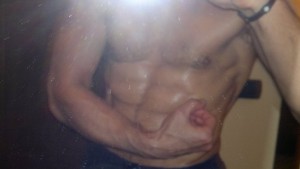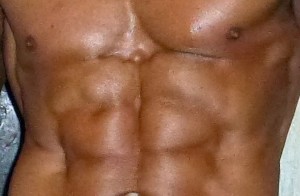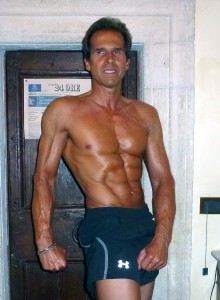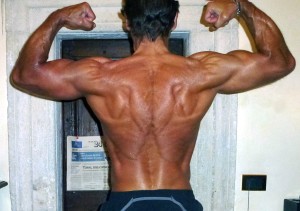Titolo: P90X2 DI BENE IN MEGLIO…SECONDO ME
Autore: Piero Maina
Conteggio Parole: 1511

Come è possibile migliorare un prodotto che è già di per se il massimo nella sua categoria? Ci ha provato con successo Tony Horton creando il nuovo programma di allenamento P90X2 che è il successore del P90X. Per chi non conosce il P90X, lo rimando alla lettura del precedente articolo P90X – Ritrovare la forma…la mia esperienza , per chi invece ha già provato i benefici derivanti dal programma e ora ha/avrebbe intenzione di proseguire oltre con il P90X2, può trovare qui di seguito la mia esperienza dopo i primi due mesi di allenamento e il mio punto di vista riguardo il programma.
Cos’è il P90X2? Come recita il libretto di presentazione, si tratta dell’evoluzione del programma di allenamento P90-X per arrivare ad essere nella migliore forma fisica della vostra vita. Così come il suo predecessore P90X, il P90X2 è un programma da completare in 90 giorni, (ma si può usare in maniera flessibile e diversamente dal programma base si può completare in più tempo, anche in sei settimane per ciascuna fase di allenamento che come per il P90X sono tre) una continuazione del viaggio iniziato con il P90X e un ulteriore sfida per il raggiungimento della composizione muscolare ottimale e del rapporto fra massa grassa e massa magra e di miglioramento delle nostre doti atletiche.
Qual è la differenza fra il P90X e il P90X2? Considerate il P90X2 come il passo successivo. Sempre fondato sui principi del P90X e sulla “confusione muscolare”, utilizza gli stessi concetti per la trasformazione corporea, ma con un’attenzione maggiore a funzionalità, agilità, equilibrio, mobilità e naturalmente anche ad un miglioramento dei risultati visibili. Quindi miglioramento nelle prestazioni e miglioramento nei risultati che possiamo vedere ad occhio nudo, ma con la diversità rispetto al P90X di ridurre a 5 sedute settimanali gli allenamenti e a due sessioni di stretching e recupero attivo, (chiamate Recovery + Mobility) così da donare maggior riposo al nostro fisico e permettergli un recupero maggiore. Il motto è: “Quando di meno vuol dire di più”. Come ben sapete e avete imparato durante gli allenamenti con il P90X, il nostro fisico progredisce,cresce e aumenta in forza solo quando il recupero è sufficiente dopo sessioni di allenamento impegnative.
Prima di cominciare con il programma di allenamento, così come richiesto dal P90X, sarà necessario sottoporsi al test di entrata per il P90X2. Il test è lo stesso, anche perchè il P90X2 non è che sia più “duro” del P90X, è però composto da nuovi esercizi che coinvolgono diversamente i nostri muscoli. Certo la prima volta che abbiamo provato il P90X ci siamo chiesti se esisteva qualcosa di più faticoso e ci sembrava veramente una sfida impossibile. Questa volta arrivando già allenati al P90X2, non sarà difficile superare il test di entrata, ma vi assicuro che le prime settimane saranno necessarie per abituarsi ai nuovi esercizi che vedranno sempre presenti le “medicine balls” e la “stability ball“; questo al fine di aumentare ulteriormente la confusione muscolare e il nostro equilibrio e a rendere più impegnativi gli stessi esercizi.
Vediamo da vicino come sono suddivise le tre fasi di allenamento che come già detto sopra, non dureranno necessariamente quattro settimane ciascuna, ma anche sei settimane. La prima fase è chiamata “Foundation”, la seconda “Strength” e la terza “Performance”. La prima fase o fase 1 (Costruiamo le fondamenta), focalizza maggiormente le “fondamenta” o meglio il nostro modo di essere collegati al terreno. Questo non significa solo le gambe, ma tutta la nostra catena cinetica composta dai muscoli,scheletro e sistema nervoso. C’è un vecchio detto che dice :” Non si può sparare con un cannone da una canoa”. In poche parole se la base non è solida, il resto lo sarà ancor meno, soprattutto quando tenteremo di fare esercizi di forza esplosiva. L’obiettivo della fase 1 è di creare solide basi al terreno,così da poter effettuare tutti gli altri movimenti senza compromettere la forma durante l’esecuzione. Quando questo processo sarà completato, apparirete in una forma migliore e le vostre performances saranno migliori.
La seconda fase o Fase 2 (Diventare più forti), da qui si consolida la forza delle nostre fondamenta e si rafforza tutta la parte superiore del nostro corpo. Diciamo che si ritorna ai più familiari esercizi già effettuati con il P90X, ma la differenza è che questa volta verranno eseguiti da posizioni e situazioni instabili e che richiedono sicuramente maggiori doti atletiche, In questa fase, soprattutto se seguiremo il giusto piano alimentare e inseriremo gli esercizi contenuti nei due DVD extra, V Sculpt e X2 Chest + Shoulders+Tris da alternare a Chest+ Back + Balance e X2 Shoulders, vedremo maggiormente i risultati nel cambiamento del nostro corpo a livello di composizione, in termini di perdita di grasso e aumento della massa muscolare. In questa fase soprattutto se la prolungheremo a 6 settimane la confusione muscolare sarà ai massimi livelli.
La terza fase o fase 3 (Miglioriamo le nostre performances – Risultati esplosivi), fase dedicata alle prestazioni atletiche pure,frutto di esercizi e movimenti complessi da qui il nome degli esercizi (P.A.P. Lower/Upper Post Activation Potentiation), esercizi che sono strutturati per “distruggerci”, ma quando compresi ed eseguiti ci daranno una forma strepitosa facendoci sentire più agili scattanti e giovani.
Come sapete io sono ancora nella fase due e ho completato tutti gli esercizi presenti nel programma P90X2 al di fuori dei P.A.P. che sono presenti nella fase 3 e quindi volevo dare qui di seguito la mia impressione. Ho trovato fantastica la fase 1 che ha messo a dura prova la mia forma pur essendo perfettamente allenato e proveniente dal P90X che eseguivo senza grossi problemi in tutti gli esercizi. Questo però è stato gratificante perchè ho migliorato la mia situazione a livello di muscolatura “core” e ne ho tratto beneficio nello sport che pratico principalmente che è il golf, ma anche nello sci dove la risposta delle mie gambe è stata ottimale e dal punto di vista atletico e della forma in generale e un miglior equilibrio psicofisico. La novità rispetto al P90X è stata l’introduzione di nuovo materiale per l’allenamento, infatti la maggiorparte degli esercizi si svolgono con l’ausilio delle medicine balls e della stability ball, sempre alla ricerca dell’equilibrio e della funzionalità lavorando costantemente in situazioni instabili. La medicine ball che in Italia chiamiamo anche palla medica, non va comunque acquistata come quella classica in cuoio morbido, ma deve essere di gomma,compatta al fine di permetterci di utilizzarla per gli esercizi. (Io le posseggo da 4 e 6 kg.) Il nuovo programma dedicato allo stretching prevede la new entry del Foam Roller/Rumble Roller per il self massage…un vero toccasana. Vi posso assicurare che dopo una sessione di Recovery + Mobility fatta con il Foam o Rumble Roller vi sentirete pieni di energia e otterrete una grande flessibilità e vi sentirete pronti ad affrontare al meglio gli esercizi del giorno dopo e la vita in generale riducendo di molto la possibilità di infortunarvi. Che dire poi del programma yoga, certamente non è una vera e propria seduta di yoga, ma così com’è strutturato ed inserito nel P90X-2, il benessere che ne ricaverete supera di gran lunga la fatica anche se pure per lo yoga bisogna essere preparati in termini di flessiblità e forza è veramente impegnativo. Il Plyocide che è l’evoluzione del precedente Plyometric è fenomenale, salti, flessioni e attività aerobica in equilibrio spinta ai massimi livelli, magari non come l’insanity, ma certamente impegnativo e stimolante…e gli addominali? Qui a differenza degli AB ripper X del P90X si è più sul core e sulla contrazione concentrata e di resistenza. Anche per chi come me ha il suo punto forte nell’addome, troverà faticoso adattarsi ai nuovi esercizi e impiegherà un po’ prima di eseguire in maniera composta e controllata tutti gli esercizi che durano i soliti 16 minuti e si fanno sempre dopo le sessioni di allenamento principale. Comunque sono in programma solo una volta a settimana nella fase 1 e tre volte nella fase 2. Diciamo che nella fase 1 essendo il tutto finalizzato al lavoro sul “core”, gli addominali lavorano già durante le normali sessioni di allenamento.
Vi invito quindi a provare il P90X2, certo gli esercizi tipo i piegamenti sulle braccia su 4 medicine balls, due sotto le mani e due sotto i piedi e i piegamenti fatti con le gambe sulla Stability ball e le mani su una medicine ball non sono proprio alla portata di tutti, ma sono sempre presenti i dimostratori che ci presentano gli esercizi con modifiche/semplificati anche nel caso che ci troviamo in viaggio e siamo in albergo e vogliamo allenarci con il materiale di fortuna presente nella nostra camera.
In sintensi possiamo allenarci dovunque e comunque, basta averne voglia. Non dimenticate che per ottenere i risultati migliori e non vanifcare gli sforzi fatti, sarà necessario seguire anche un regime alimentare corretto e volendo c’è un libretto per la corretta alimentazione incluso,anche se io continuo a seguire Burn The Fat Feed The Muscle e potete sempre vedere i miei risultati riguardo l’esperienza fatta, leggendo l’articolo “Burn The Fat….La Mia Esperienza” qui.
Come dice Tony Horton: “Do your best and forget the rest!” “Bring it!”
© Copyright 2012 – 2024 Piero Maina – Tutti i diritti riservati














